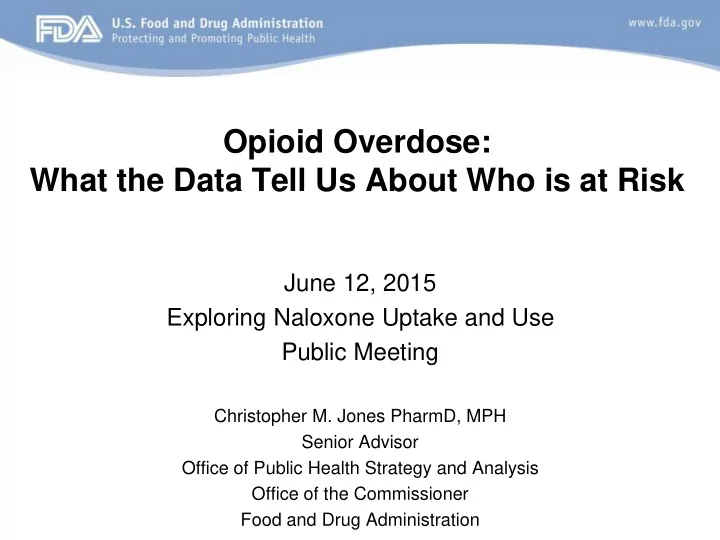

Opioid Overdose: What the Data Tell Us About Who is at Risk June 12, 2015 Exploring Naloxone Uptake and Use Public Meeting Christopher M. Jones PharmD, MPH Senior Advisor Office of Public Health Strategy and Analysis Office of the Commissioner Food and Drug Administration
Overview • Background • Patients receiving prescription opioids • Potential data sources to identify patients for naloxone co-prescription 2
BACKGROUND 3
Who Should Receive Naloxone Patient Characteristics Naloxone Provision People with prior history of overdose People receiving medical care for an opioid overdose People who inject drugs People with opioid use disorder People released from criminal justice system with history of opioid abuse Patients receiving opioids for pain / ? 4
PATIENTS RECEIVING PRESCRIPTION OPIOIDS 5
Patients Receiving Prescription Opioids • Should all patients be offered naloxone? • What do the data tell us about who is at risk for an overdose? 6
Prescription History Among People with Opioid Poisoning 60 50 Percent of patients with opioid poisoning 40 30 20 10 0 1 2-10 >10 1-29 30-89 ≥ 90 1-19 20-49 50-89 90-119 ≥ 120 Number of Opioid Rxs In Year Total Days Supply in Year MED/Day in Week Prior to Event Before Event Before Event 7 Source: Fulton-Kehoe, Garg, Turner et al. J Ind Med. 2013
Past Year Prescription Behaviors Among Opioid Overdose Deaths n=2,024,551 50 47.1 44.6 45 40 Percent of patients receiving an opioid 35 30 25 20 15 10 7.6 5 2.8 2.5 1.6 0.3 0 1 Rx 2-12 Rxs ≥ 25 Rxs ≥ 4 Prescribers ≥ 4 RPHs > 100 MMEs 3 High-risk factors 8 Source: Baumblatt et al.,. JAMA IM. 2014;174:796-801.
Opioid Overdose Deaths and Relationship with Multiple Prescribers and Pharmacies 9 Source: Baumblatt et al.,. JAMA IM. 2014;174:796-801.
Opioid Overdose and Relationship with Opioid Dose 10 Source: Baumblatt et al.,. JAMA IM. 2014;174:796-801.
Opioid Overdose and Relationship with Opioid Dose 10 100 8.87 9 90 8 80 Risk (Odds Ratio) 7 70 % Patient Years 6 60 3.73 5 50 4 40 3 30 1.44 1 2 20 1 10 0 0 1-19 20-49 50-99 100+ Opioid dosage (MME/d) 11 Source: Dunn et al, Ann Int Med 2010.
Opioid Overdose and Relationship with Opioid Dose Pct of Controls Pct of Deaths Pct of MME 100 89.8 90 80 70 57.8 60 Percent 48.4 50 40 32.2 26.8 30 20 13.8 11.0 10 5.5 4.4 4.3 3.5 2.6 0 <20 >20-40 >40-100 >100 Average Opioid Dosage over six months (MME/day) 12 Source: Unpublished data from New Mexico case-control study. Paulozzi et al, Pain Medicine. 2012.
Opioid Overdose and Relationship with Opioid Dose Acute Pain Dx CNCP Dx 2.0 Overdose death rate per 1,000 person-months 1.8 1.6 1.4 1.2 1.0 0.8 0.6 0.4 0.2 0.0 0 1 to < 20 20 to < 50 50 to < 100 ≥ 100 13 Maximum prescribed daily opioid dose, mg/day Source: Bohnert et al., JAMA 2011.
Opioid Overdose Incidence Rate by Prescription History 30 26.3 25 Incidence rate, per 1,000 person-years 20 18.5 15 10.7 10 4.3 5 0 No Shopping/No Overlap No Shopping/Overlap Shopping/No Overlap Shopping/Overlap -Overlapping prescriptions defined as 2 prescriptions of the same drug type that overlapped by 25% of the days prescribed, with the initial dispensed prescription having a supply time of 5 days or longer. 14 - Pharmacy shopping defined as ≥ 4 pharmacies in a 90 day setting. Source: Yang, W ilsey, Bohm, et al. J Pain 2015
Small Percentage of Patients Account for Greatest Risk Non-users Other users Daily users 1.0 100 11.1 9.7 Percent of Patients and Percent of Events 90 25.0 32.4 80 25.9 70 60 43.6 30.0 50 89.3 40 63.1 30 20 37.5 31.4 10 0 Patients Drug abuse diagnoses Drug overdoses Opioid overdoses 15 Source: Paulozzi, Zhang, Jones, Mack, J Am Board Fam Med. 2014
Additional Considerations for People Receiving Prescription Opioids • Concurrent benzodiazepine or other sedative/hypnotic prescription • History of non-opioid substance use disorder • History of mental health disorder • Underlying respiratory conditions • Family member/co-habitant at-risk for opioid overdose 16
POTENTIAL DATA SOURCES TO IDENTIFY PATIENTS FOR NALOXONE CO-PRESCRIPTION 17
Data sources • PDMPs • Insurer/PBM claims data • EHR systems • ED data systems 18
Conclusions • There is not yet consensus on which patients receiving prescription opioids should be offered naloxone • The available data provide a foundation for developing a risk-based approach to naloxone co-prescription – Common factors among overdose decedents include: • High opioid dose, longer duration of treatment, and large supply; concomitant benzodiazepine Rx, multiple providers/pharmacies, history of SUD/MH, underlying respiratory conditions • Some advocate a strategy of offering naloxone to all patients receiving prescription opioids • Additional research is needed to identify most effective strategy for naloxone co-prescription 19
Questions? Christopher.M.Jones@fda.hhs.gov The findings in this presentation do not represent the official position of the US Food and Drug Administration, the Department of Health and Human Services, or the U.S. Government 20
Recommend
More recommend